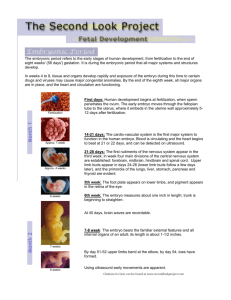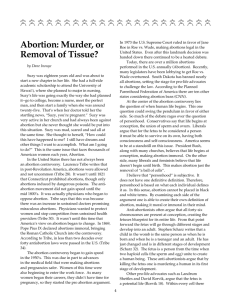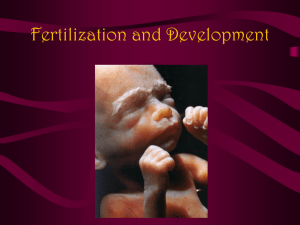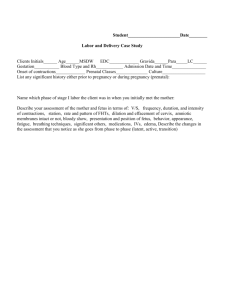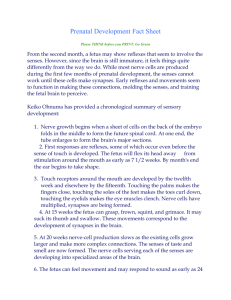Fetal Development - Health and Welfare
advertisement
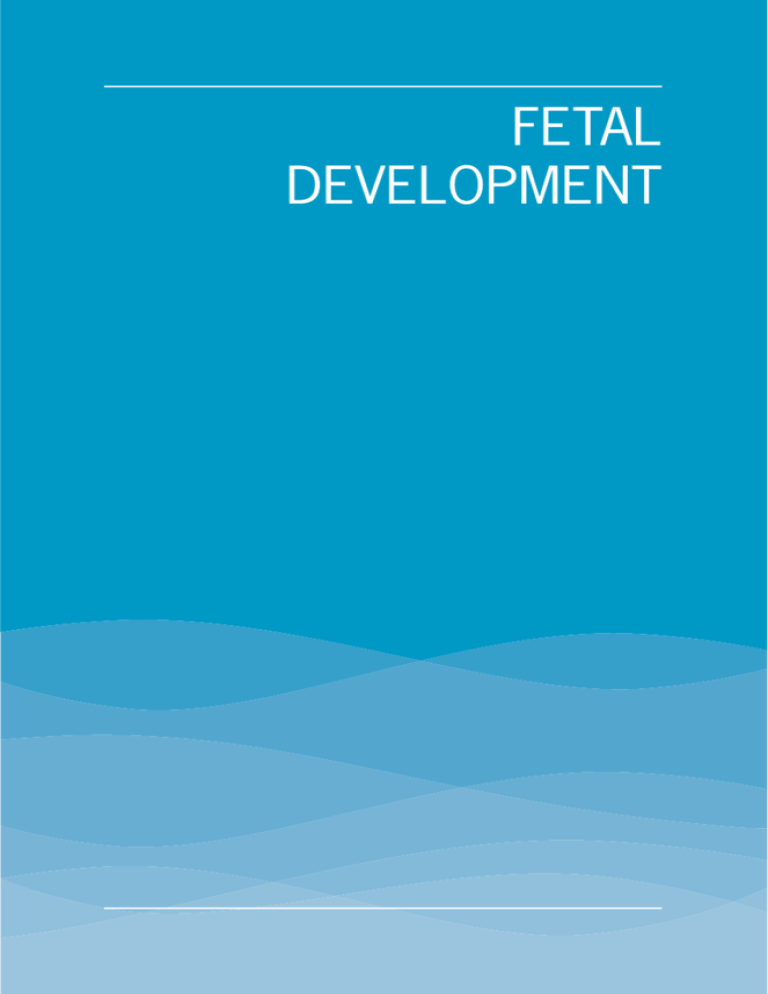
FETAL DEVELOPMENT FIRST TRIMESTER IMPLANTATION Development begins on the day a woman’s egg is fertilized by a sperm penetrating it. The fertilized egg or zygote immediately begins to divide into 2 cells, then 4, then 8, and so on. Within a few days the cluster of between 13 and 32 cells leave the fallopian tube and move into the uterus. This group of cells is now called a blastocyst and has increased in size to hundreds of cells. By the eighth day after conception, the blastocyst has begun to attach to the wall of the uterus (implantation) where it will grow at a rapid rate. The term “embryo” refers to a developing human from implantation through the eighth week of pregnancy. Beginning with the ninth week, the embryo is referred to as a fetus until the moment of birth. Ages in this booklet are listed from both the estimated day of conception and from the first day of the last normal menstrual period. Lengths are measured from the top of the head to the rump. 2 WEEKS (4 WEEKS AFTER THE FIRST DAY OF THE LAST NORMAL MENSTRUAL PERIOD) • • • A pregnant woman may notice her first missed menstrual period at the end of the second week after conception, or about 4 weeks after the first day of her last normal period. Following implantation, the blastocyst is called an embryo. The embryo is about 1/100 of an inch long at this time; it is about the size of a pinhead. 1 4 WEEKS (6 WEEKS AFTER THE FIRST DAY OF THE LAST NORMAL MENSTRUAL PERIOD) FIRST HEARTBEATS A distinct blood vessel has now formed inside the embryo. It will later develop into the heart and circulatory system of the child. By 5 weeks, the embryo’s heart is tubular in shape and begins to beat. The connections between the pregnant woman and the embryo are developing to form the placenta. The placenta will nourish the embryo, then the fetus, for the remainder of its stay in the uterus. LENGTH: 1/4 inch • • • • The embryo has developed a head and a trunk. Structures that will become arms and legs, called limb buds, begin to appear. A blood vessel forms which will later develop into the heart and circulatory system. Blood is beginning to be pumped and is visible by ultrasound. During this time, a ridge of tissue forms down the length of the embryo. That tissue will later develop into the brain and spinal cord. 2 6 WEEKS (8 WEEKS AFTER THE FIRST DAY OF THE LAST NORMAL MENSTRUAL PERIOD) ORGAN FORMATION The cells of the embryo are continuing to multiply, forming more organs, including the brain. Blood is being pumped through the umbilical cord to and from the embryo. At the other end of the embryo, a distinct tail bud, the end of the spinal cord, is present. The spinal column or spine is made up of cartilage at this stage. The embryo is now surrounded by a sac filled with amniotic fluid. The fluid within this sac protects the embryo. LENGTH: 1/2 to 3/4 inches • • • • The heart now has 4 chambers. Fingers and toes begin to form. Reflex activity begins with the development of the brain and nervous system. Cells are starting to form the eyes, ears, jaws, lungs, stomach, intestines, and liver. 3 8 WEEKS (10 WEEKS AFTER THE FIRST DAY OF THE LAST NORMAL MENSTRUAL PERIOD) A FETUS From the end of the eighth week until delivery, the embryo is now called a fetus. The head of the fetus is large and makes up about half of its entire size. The tail bud has now disappeared, and the first real bone cells are beginning to replace the cartilage throughout the fetus. Facial features are becoming apparent, and the eyes, ears, arms, and legs are more identifiable. LENGTH: 1 - 1/2 inches • • • The fetus weighs less than 1/2 ounce. The beginnings of all key body parts are present, although they are not completely positioned in their final locations. Muscles and skeleton are developing, and the nervous system becomes more responsive. 4 10 WEEKS (12 WEEKS AFTER THE FIRST DAY OF THE LAST NORMAL MENSTRUAL PERIOD) RANDOM MOVEMENTS At this stage of its development, all major body organs have formed inside the fetus. These organs would not be able to function if the fetus were outside of the uterus. Between 10 and 12 weeks, the fetus begins to make small random movements. At 12 weeks, however, these movements are too slight to be felt by the woman. LENGTH: 2 - 1/2 inches WEIGHT: 1/2 ounce • • • • Fingers and toes are distinct and have nails. The fetal heartbeat can be detected with a Doppler or heart monitor. All major external body features have appeared. Muscles continue to develop. 5 12 WEEKS (14 WEEKS AFTER THE FIRST DAY OF THE LAST NORMAL MENSTRUAL PERIOD) BOY OR GIRL? The head of the fetus continues to be the largest feature while the arms are in proportion to the rest of the body. The eyes are now beginning to grow toward the front of the head and have lids. The bridge of the nose is also forming. The fetus now has 20 buds in place for baby teeth and can open and close its mouth as well as swallow. The external genitals have also been forming, and a doctor may be able to tell the sex of the fetus using a special test. LENGTH: 3 - 1/2 inches WEIGHT: 1 – 1/2 ounces • • • The kidneys make urine, and blood begins to form in the bone marrow. Joints and muscles allow full body movement. The fetus now sleeps and wakes. 6 SECOND TRIMESTER 14 WEEKS (16 WEEKS AFTER THE FIRST DAY OF THE LAST NORMAL MENSTRUAL PERIOD) LIMBS WELL-DEVELOPED The legs of the developing fetus are becoming well defined. The head of the fetus is still large in comparison to other body parts and is now held erect. LENGTH: 5 inches WEIGHT: 4 ounces • • • The skin appears transparent. A fine layer of hair has begun to grow on the head. Limb movements become more coordinated. 7 16 WEEKS (18 WEEKS AFTER THE FIRST DAY OF THE LAST NORMAL MENSTRUAL PERIOD) KICKING AND SLEEPING All of the body and facial features are now recognizable. The fetus can now blink, grasp, move its mouth, and sleep. The fetus has also begun to kick, although the pregnant woman most likely can still not feel the movement. LENGTH: 5 - 1/2 inches WEIGHT: 8 ounces • • • Ears are now visible on the sides of the head. The skin is still transparent. Hair and nails begin to grow. 8 18 WEEKS (20 WEEKS AFTER THE FIRST DAY OF THE LAST NORMAL MENSTRUAL PERIOD) DOWNY HAIR APPEARS By 20 weeks, fine, downy hair has begun to appear on the remainder of the body of the fetus. Functions associated with respiratory processes begin, although the lungs of the fetus are not yet fully developed. The exchange of oxygen and carbon dioxide is still done in the placenta at this point. At 20 weeks, the fetus cannot survive outside of the uterus. LENGTH: 6 - 1/4 inches WEIGHT: 3/4 of a pound • • • • All organs and structures have been formed, and a period of simple growth begins. The skin is covered with vernix – a greasy material that protects the skin. By this time, the woman may feel the fetus moving. If an ultrasound is performed at this time, the parents may be told the sex. 9 20 WEEKS (22 WEEKS AFTER THE FIRST DAY OF THE LAST NORMAL MENSTRUAL PERIOD) TURNING SIDE TO SIDE At 22 weeks, the kidneys of the fetus are beginning to work and the air sacs of the lungs are continuing to develop. As the skin begins to turn opaque, sweat glands develop. The fetus now becomes more active and can turn side to side. The woman will continue to feel movement. LENGTH: 7 - 1/2 inches WEIGHT: 1 pound • • • • • The fetus has fingerprints. The fetus may suck its thumb and is more active. This is a time of extremely rapid brain growth. The fetal heartbeat can be heard with a stethoscope. There is little chance that a baby could survive outside the woman’s body. 10 22 WEEKS (24 WEEKS AFTER THE FIRST DAY OF THE LAST NORMAL MENSTRUAL PERIOD) SKELETAL DETECTION By 24 weeks, eyebrows and eyelashes are more noticeable. The skin of the fetus is wrinkled, but still very thin. At this point in the development, the first layers of fat are beginning to form, and a fetal skeleton can be recognized. LENGTH: 8 - 1/2 inches WEIGHT: 1 – 1/4 pounds • • • • Bones of the ears harden, making sound conduction possible. The fetus hears the pregnant woman’s sounds such as breathing, heartbeat, and voice. This is the beginning of substantial weight gain for the fetus. Changes are occurring in lung development so that some babies are able to survive (with intensive care services). Surviving babies may have disabilities and require longterm intensive care. 11 THIRD TRIMESTER 24 WEEKS (26 WEEKS AFTER THE FIRST DAY OF THE LAST NORMAL MENSTRUAL PERIOD) RESPONDS TO SOUND The fetus can now respond to sound from both inside the pregnant woman’s body and outside in her surroundings. At this stage, most of the babies born alive will survive if they are born in a hospital with the appropriate medical technology and experts. These babies will require long stays in a neonatal intensive care unit, and at least 1 in 4 will have permanent disabilities. LENGTH: 9 inches WEIGHT: 2 pounds • • • • • Reflex movements improve and body movements are stronger. The lungs continue to develop. The fetus now wakes and sleeps. The skin has turned red and wrinkled and is covered with fine hair. Almost 8 out of 10 babies born now may survive (with intensive care services). 12 26 WEEKS (28 WEEKS AFTER THE FIRST DAY OF THE LAST NORMAL MENSTRUAL PERIOD) SUCKS ITS THUMB The fetus continues to develop and grow throughout the next 12 weeks. The eyes are now partially open, and the fetus can suck its thumbs. The thin, red, wrinkled skin of the fetus is covered with a white substance that resembles cheese. This substance is called vernix caseosa, and it protects the skin from the drying effects of the amniotic fluid. LENGTH: 10 inches WEIGHT: 2 – 1/2 pounds • • • • The mouth and lips show more sensitivity. The eyes are partially open and can perceive light. Brain wave patterns resemble those of a full term baby at birth. About 9 out of 10 babies born now will survive (with intensive care services). 28 WEEKS (30 WEEKS AFTER THE FIRST DAY OF THE LAST NORMAL MENSTRUAL PERIOD) OPEN EYES The fetus has lungs that can breathe air, although, if it is born at this stage, it may need medical help to do so. Fat is beginning to develop on the body of the fetus, and it is becoming more rounded. At this stage, the fetus can open and close its eyes and cry. LENGTH: 10 - 1/2 inches WEIGHT: 3 pounds • • Rhythmic breathing and body temperature are now controlled by the brain (or central nervous system). Nearly all babies born now will survive (with intensive care services). 13 30 WEEKS (32 WEEKS AFTER THE FIRST DAY OF THE LAST NORMAL MENSTRUAL PERIOD) WRINKLES ON SOLES OF FEET From this stage on, fetal development centers mostly around growth. The fetus continues to gain weight and produce more fat. Wrinkles have appeared on the soles of the feet. A thick coat of vernix caseosa continues to form on the skin of the fetus. LENGTH: 11 inches WEIGHT: 3 pounds • • • The skin is thicker and less red. There is an increase in the connections between the nerve cells in the brain. Almost all babies born now will survive (with intensive care services). 32 WEEKS (34 WEEKS AFTER THE FIRST DAY OF THE LAST NORMAL MENSTRUAL PERIOD) 99% SURVIVAL The fetus is gaining weight steadily at approximately ½ pound per week. At this stage, the fetus begins to turn its head downward in preparation for birth. The survival rate at 34 weeks is about 99 percent. Some babies born at this stage will require intensive care; only a few will have permanent disabilities. A few babies born at 34 weeks will be able to leave the hospital with their mothers and will not require intensive care. LENGTH: 12 inches WEIGHT: 4 – 1/2 pounds • • • The ears begin to hold shape. The eyes open during alert times and close during sleep. The skin is now smooth. 14 34 WEEKS (36 WEEKS AFTER THE FIRST DAY OF THE LAST NORMAL MENSTRUAL PERIOD) ALMOST FULLY DEVELOPED The fetus is almost fully developed. The body is more round and plump. The face is less wrinkled. The lanugo, or hair, disappears from the face of the fetus but remains on the head. The fetus should now be in the correct position for birth. LENGTH: 12 - 1/2 inches WEIGHT: 5 – 1/2 pounds • • Muscle tone has now developed, and the fetus can turn and lift its head. Almost all babies born now will survive. 36 WEEKS (38 WEEKS AFTER THE FIRST DAY OF THE LAST NORMAL MENSTRUAL PERIOD) GRASPS FIRMLY The fetus can now grasp firmly. rounded. Its body appears plump and LENGTH: 13 - 1/2 inches WEIGHT: 6 – 1/2 pounds • • • The lungs are usually mature. The fetus turns toward light sources. Almost all babies born now will survive. 15 38 WEEKS (40 WEEKS AFTER THE FIRST DAY OF THE LAST NORMAL MENSTRUAL PERIOD) FULL TERM At 40 weeks, the fetus is considered full term. All body parts are fully developed, and the fetus can survive outside of the uterus. The chest of the fetus is defined, and the breasts jut out. LENGTH: 14 inches WEIGHT: 7 pounds • • At the time of birth, a baby can display more than 70 reflex behaviors which are automatic and unlearned behaviors necessary for survival. The baby is full-term and ready to be born. PHOTOS The photos on pages 2, 4, 5, 6, 7, 8, 9, 10, 11, and 12 are from Lennart Nillsson/Albert Bonniers Forlag AB, A Child is Born, Dell Publishing Company. The photo on page 3 is from Robert L. Wolfe© Photography, Minneapolis, MN. 16

